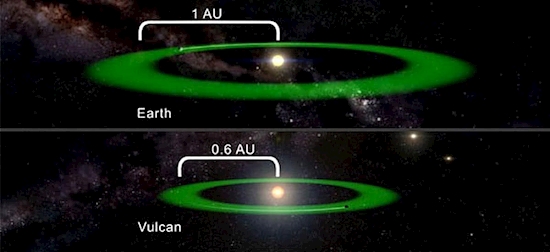The Search for Extrasolar Planets Goes Hollywood
In all the Star Trek series, the humanoid species called the Vulcans brought viewers some of the most memorable characters. The one everyone remembers is Mr. Spock (brought to life by the late Leonard Nimoy), the half-human, half-Vulcan son of Ambassador Sarek and his wife Amanda. In the rebooted Star Trek movie from 2009, we see Spock in his youth and see the home world of Vulcan destroyed. We know a lot about these humanoids and interspersed through all the shows are fascinating bits of future space technology, but also a fair amount of astronomy. Let's look at one: the Vulcan homeworld.
Spock's Home Planet
Vulcan supposedly orbits a star called 40 Eridani A,a star that really exists. It lies about 16 light-years from Earth in the constellation Eridanus. Its more formal name is Omicron 2 Eridani, and is informally also known as Keid (from the Arabic word for "egg shells"). In reality, this star is a triple star system, but the primary (which is the brightest one) is what we call 40 Eridani A. It's about 5.6 billion years old, just over a billion years older than the Sun, and is what astronomers call a main-sequence K-type dwarf star. Its two companions orbit at about the same distance that Pluto does to our Sun. 40 Eridani A is slightly reddish-orange-colored and is somewhat cooler and smaller than the Sun.
Could 40 Eridani A have a planet Vulcan orbiting it? Unfortunately, there has been no detection of such a world there — yet. 40 Eridani A does have a habitable zone that could support a planet with liquid water. It would circle the star in about 223 days, much shorter than Earth's year. It's not likely any planets that formed would still exist in this three-star system, but if they did, we could talk about what they're like, particularly if one existed in just the right place to support life.
In the Star Trek universe, Vulcan is shown to be a world with stronger gravity and a somewhat thinner atmosphere than Earth has. The climate could be somewhat Earth-like, although not identical to what we enjoy here. Vulcan could be getting just enough light and heat from 40 Eridani A to help life survive and keep water liquid. For the world to be the desert planet we see in the Trek series, Vulcan would need to be a little drier, and that would limit the density of its atmosphere. It might be more like Mars, but with more atmospheric gases and somewhat more water vapor.
If the planet is more dense than Earth (that is, if it has more iron in its crust and core), then that would explain the heavier gravity.
These few planetary facts would help explain the physical characteristics of the Vulcans and their cultural adaptation to such a world. Whether they arose on Vulcan or came there from somewhere else, the Vulcans had to get used to warmer weather, desert-like terrains split by mountain ranges, and less oxygen to breathe. Luckily, in the show, humans could survive on Vulcan, but they tended to tire out more quickly and did not have the physical strength the Vulcans did.
While Vulcan and the Vulcan race do not exist, this is the sort of thought experiment that astronomers do as they search out worlds around other stars. To even begin to figure out if a distant world supports life, they need to know as much as they can about its orbit, its parent star, and the conditions on both. A hot star and a close-in planet, for example, would be a very unlikely place to look for life. A star with a world in its habitable zone is a good candidate for a life-supporting world, and future studies of such places will look at the world's atmosphere for signs of life.
As we search the worlds of our own solar system for habitable zones, places where water could exist — particularly on Mars, which is the target of the first major human missions to another planet — we could do worse than to look at our own science fictional views of life on other planets. We've long imagined life on other worlds through science fiction. It's time to find out how much our stories could match reality.
Source: www.thoughtco.com

